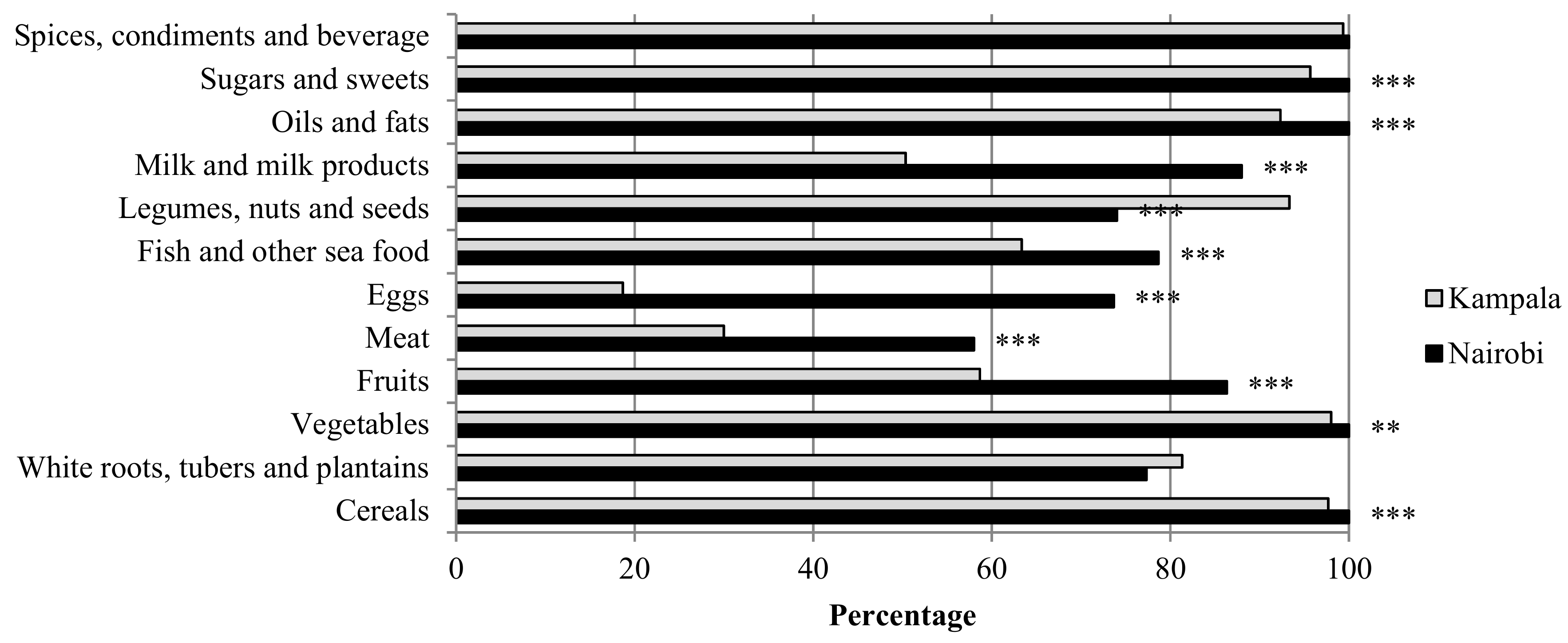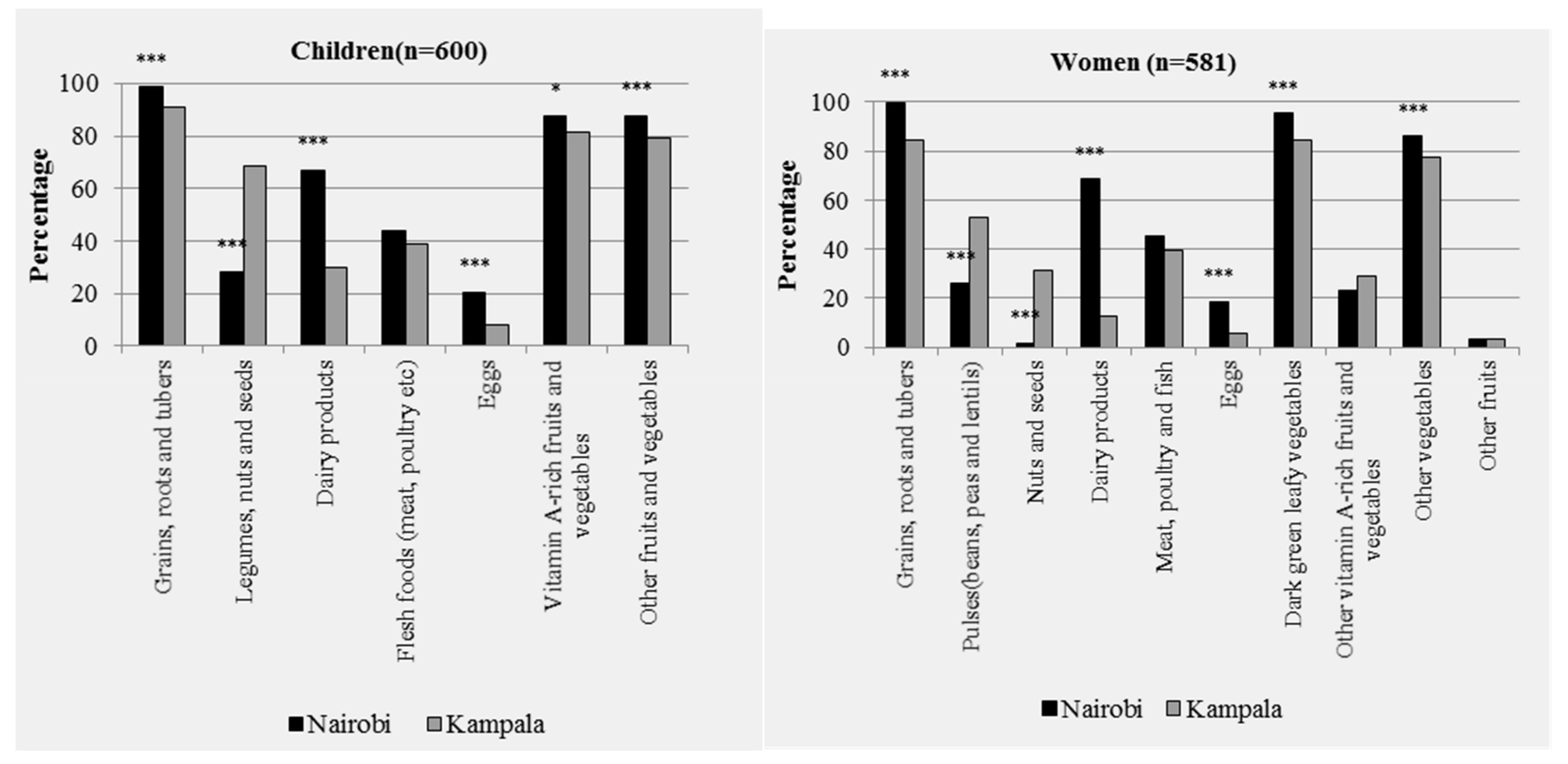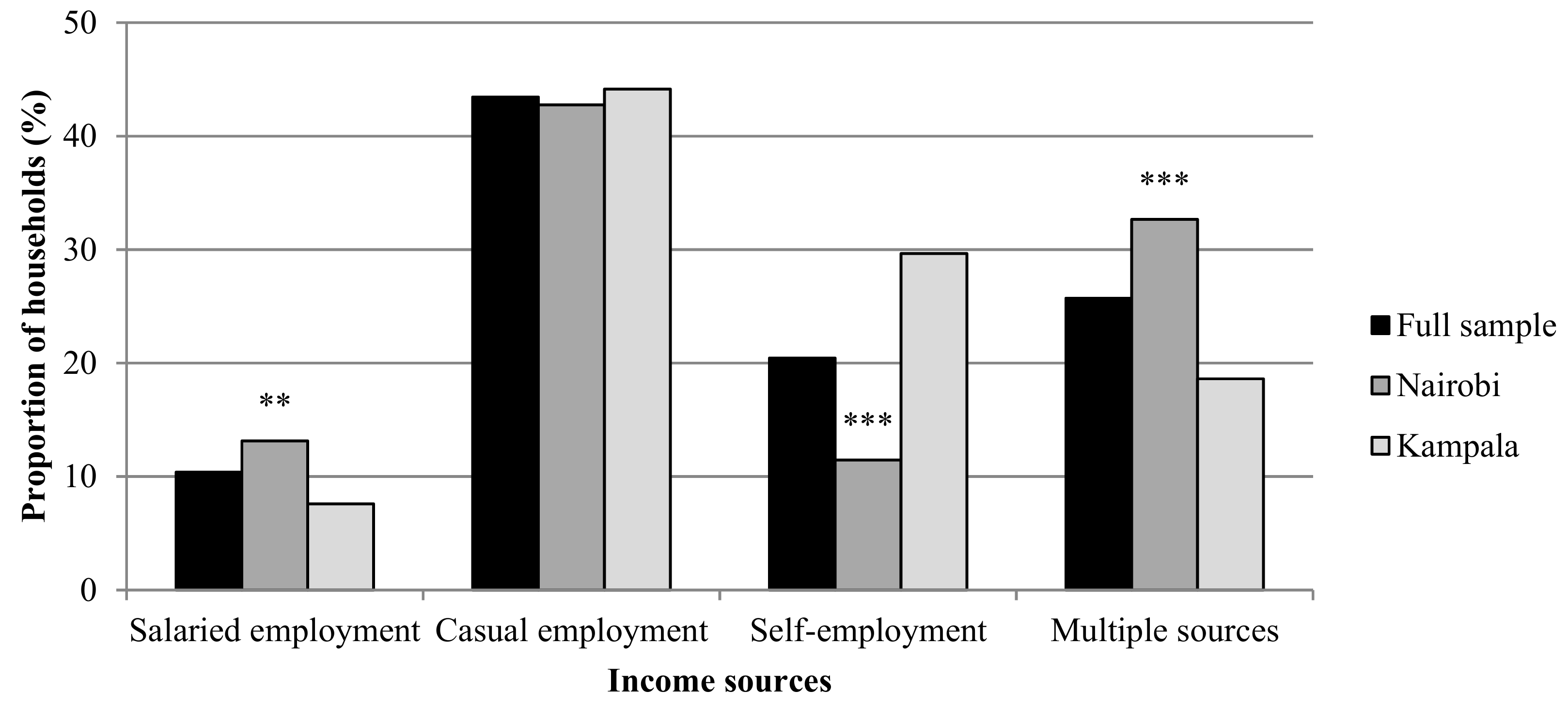Food Security and Dietary Quality in African Slums
Abstract
:1. Introduction
2. Materials and Methods
2.1. Household Survey
2.2. Food Security Indicators
2.3. Dietary Quality Indicators
2.4. Statistical Analyses
2.5. Regression Models
3. Results
3.1. Socioeconomic Characteristics
3.2. Food Security and Dietary Quality
3.3. Correlation between Indicators
3.4. Socioeconomic Factors Influencing Food Security and Dietary Quality
3.5. The Role of Employment Activities
4. Discussion and Conclusions
Supplementary Materials
Author Contributions
Funding
Acknowledgments
Conflicts of Interest
References
- United Nations. World Urbanization Prospects: The 2018 Revision. Available online: https://esa.un.org/unpd/wup/Publications (accessed on 10 December 2018).
- Greif, M.J.; Dodoo, F.N.; Jayaraman, A. Urbanization, poverty and sexual behavior: The tale of five African cities. Urban Stud. 2011, 48, 947–957. [Google Scholar] [CrossRef] [PubMed]
- Kimani-Murage, E.W.; Schofield, L.; Wekesah, F.; Mohamed, S.; Mberu, B.; Ettarh, R.; Egondi, T.; Kyobutungi, C.; Ezeh, A. Vulnerability to food insecurity in urban slums: Experiences from Nairobi, Kenya. J. Urban Health 2014, 91, 1098–1113. [Google Scholar] [CrossRef] [PubMed]
- Tacoli, C. Food (in) security in rapidly urbanizing, low-income contexts. Int. J. Environ. Res. Public Health 2017, 14, 1554. [Google Scholar] [CrossRef] [PubMed]
- APHRC. Population and Health Dynamics in Nairobi’s Informal Settlements: Report of the Nairobi Cross-Sectional Slums Survey (NCSS) 2012; APHRC: Nairobi, Kenya, 2014. [Google Scholar]
- World Bank. Population Living in Slums (% Of Urban Population). The World Data Bank. Available online: https://data.worldbank.org/indicator/EN.POP.SLUM.UR.ZS?viewchart (accessed on 5 June 2018).
- UN-Habitat. State of the World’s Cities 2010/2011: Bridging the Urban Divide; UN-Habitat: Nairobi, Kenya, 2010; Available online: https://unhabitat.org/books/state-of-the-worlds-cities-20102011-cities-for-all-bridging-the-urban-divide/ (accessed on 15 July 2018).
- Zezza, A.; Carletto, C.; Fiedler, J.L.; Gennari, P.; Jolliffe, D. Food counts. Measuring food consumption and expenditures in household consumption and expenditure surveys (HCES). Introduction to the special issue. Food Policy 2017, 72, 1–6. [Google Scholar] [CrossRef]
- Upton, J.B.; Cissé, J.D.; Barrett, C.B. Food security as resilience: Reconciling definition and measurement. Agric. Econ. 2016, 7, 135–147. [Google Scholar] [CrossRef]
- Carletto, C.; Zezza, A.; Banerjee, R. Towards better measurement of household food security: Harmonizing indicators and the role of household surveys. Glob. Food Sec. 2013, 2, 30–40. [Google Scholar] [CrossRef]
- FAO; FHI 360. Minimum Dietary Diversity for Women (MDD-W): A Guide for Measurement; FAO: Rome, Italy, 2016. [Google Scholar]
- Maxwell, D.; Vaitla, B.; Coates, J. How do indicators of household food insecurity measure up? An empirical comparison from Ethiopia. Food Policy 2014, 47, 107–116. [Google Scholar] [CrossRef]
- Headey, D.D. The impact of the global food crisis on self-assessed food security. World Bank Econ. Rev. 2013, 27, 1–27. [Google Scholar] [CrossRef]
- Ruel, M.T.; Harris, J.; Cunningham, K. Diet quality in developing countries. In Diet Quality; Humana Press: New York, NY, USA, 2013; pp. 239–261. [Google Scholar]
- De Haen, H.; Klasen, S.; Qaim, M. What do we really know? Metrics for food insecurity and undernutrition. Food Policy 2011, 36, 760–769. [Google Scholar] [CrossRef] [Green Version]
- Kennedy, G.; Berardo, A.; Papavero, C.; Horjus, P.; Ballard, T.; Dop, M.; Delbaere, J.; Brouwer, I.D. Proxy measures of household food consumption for food security assessment and surveillance: comparison of the household dietary diversity and food consumption scores. Public Health Nutr. 2010, 13, 2010–2018. [Google Scholar] [CrossRef] [Green Version]
- WHO; UNICEF; USAID; FANTA; AED; UC DAVIS; IFPRI. Indicators for Assessing Infant and Young Child Feeding Practices Part 2: Measurement; WHO: Geneva, Switzerland, 2010. [Google Scholar]
- Coates, J.; Swindale, A.; Bilinsky, P. Household Food Insecurity Access Scale (Hfias) For Measurement of Household Food Access: Indicator Guide (v. 3); Food and Nutrition Technical Assistance Project; Academy for Educational Development: Washington, DC, USA, 2007. [Google Scholar]
- Headey, D.; Ecker, O. Rethinking the measurement of food security: From first principles to best practice. Food Secur. 2013, 5, 327–343. [Google Scholar] [CrossRef]
- Barrett, C.B. Measuring food insecurity. Science 2010, 327, 825–828. [Google Scholar] [CrossRef] [PubMed]
- Hoddinott, J.; Yohannes, Y. Dietary Diversity as A Household Food Security Indicator; Food and Nutrition Technical Assistance Project (FANTA); Academy for Educational Development: Washington, DC, USA, 2002. [Google Scholar]
- Kennedy, G.L.; Pedro, M.R.; Seghieri, C.; Nantel, G.; Brouwer, I. Dietary diversity score is a useful indicator of micronutrient intake in non-breast-feeding Filipino children. J. Nutr. 2007, 137, 472–477. [Google Scholar] [CrossRef] [PubMed]
- Savy, M.; Martin-Prével, Y.; Traissac, P.; Delpeuch, F. Measuring dietary diversity in rural Burkina Faso: Comparison of a 1-day and a 3-day dietary recall. Public Health Nutr. 2007, 10, 71–78. [Google Scholar] [CrossRef] [PubMed]
- Fongar, A.; Gödecke, T.; Aseta, A.; Qaim, M. How well do different dietary and nutrition assessment tools match? Insights from rural Kenya. Public Health Nutr. 2019, 22, 391–403. [Google Scholar] [CrossRef]
- Bühler, D.; Hartje, R.; Grote, U. Matching food security and malnutrition indicators: evidence from Southeast Asia. Agric. Econ. 2018, 49, 481–495. [Google Scholar] [CrossRef]
- Kang, Y.; Hurley, K.M.; Ruel-Bergeron, J.; Monclus, A.B.; Oemcke, R.; Wu, L.S.; Mitra, M.; Phuka, J.; Klemm, R.; West, K.P.; et al. Household food insecurity is associated with low dietary diversity among pregnant and lactating women in rural Malawi. Public Health Nutr. 2019, 22, 697–705. [Google Scholar] [CrossRef]
- Cisse-Egbuonye, N.; Ishdorj, A.; McKyer, E.L.; Mkuu, R. Examining nutritional adequacy and dietary diversity among women in Niger. Mater. Child Health. J. 2017, 21, 1408–1416. [Google Scholar] [CrossRef]
- Koppmair, S.; Kassie, M.; Qaim, M. Farm production, market access and dietary diversity in Malawi. Public Health Nutr. 2017, 20, 325–335. [Google Scholar] [CrossRef]
- Tiwari, S.; Skoufias, E.; Sherpa, M. Shorter, Cheaper, Quicker, Better: Linking Measures of Household Food Security To Nutritional Outcomes in Bangladesh, Nepal, Pakistan, Uganda, and Tanzania; World Bank Policy Research Working Paper No. 6584; The World Bank: Washington, DC, USA, 2014. [Google Scholar]
- Wanyama, R.; Gödecke, T.; Chege, C.G.K.; Qaim, M. How important are supermarkets for the diets of the urban poor in Africa? Food Secur. 2019. [Google Scholar] [CrossRef]
- Wanyama, R.; Gödecke, T.; Jager, M.; Qaim, M. Poor consumers’ preferences for nutritionally enhanced foods. Br. Food J. 2019, 212, 755–770. [Google Scholar] [CrossRef]
- Kenya National Bureau of Statistics. Spatial Dimensions of Well-Being in Kenya. Where are the Poor? From Counties to Wards; KNBS: Nairobi, Kenya, 2015.
- Uganda Bureau of Statistics. National Population and Housing Census 2014, Sub-County Report. Volume I Central Region; UBOS: Kampala, Uganda, 2014.
- Sibhatu, K.T.; Qaim, M. Farm production diversity and dietary quality: Linkages and measurement issues. Food Secur. 2018, 10, 47–59. [Google Scholar] [CrossRef]
- Khonje, M.G.; Qaim, M. Modernization of African food retailing and (un)healthy food consumption. Sustainability 2019, 11, 4306. [Google Scholar] [CrossRef]
- Kennedy, G.; Ballard, T.; Dop, M.C. Guidelines for Measuring Household and Individual Dietary Diversity; FAO: Rome, Italy, 2010. [Google Scholar]
- Swindale, A.; Bilinsky, P. Household Dietary Diversity Score (HDDS) For Measurement of Household Food Access. Indicator Guide (v.2); FHI 360/Food and Nutrition Technical Assistance Project: Washington, DC, USA, 2006. [Google Scholar]
- FAO. Food Security Indicators. Available online: http://www.fao.org/economic/ess/ess-fs/ess-fadata/en/#.W9rH4NVKjIU (accessed on 1 June 2018).
- Sehmi, J.K. National Food Composition Tables and The Planning Of Satisfactory Diets In Kenya; Kenya Government Press: Nairobi, Kenya, 1993.
- Hotz, C.; Abdelrahman, L.; Sison, C.; Moursi, M.; Loechl, C. A Food Composition Table for Central and Eastern Uganda; HarvestPlus: Washington, DC, USA, 2012. [Google Scholar]
- FAO. Human Energy Requirements. Report of a Joint FAO/WHO/UNU Expert Consultation, Rome, 17–24 October 2001; FAO Food and Nutrition Technical Report Series No. 1; FAO: Rome, Italy, 2001. [Google Scholar]
- Desiere, S.; D’Haese, M.; Niragira, S. Assessing the cross-sectional and inter-temporal validity of the Household Food Insecurity Access Scale (HFIAS) in Burundi. Public Health Nutr. 2015, 18, 2775–2785. [Google Scholar] [CrossRef] [Green Version]
- Greene, W.H. Econometric Analysis, 7th ed.; Prentice Hall: Upper Saddle River, NJ, USA, 2012. [Google Scholar]
- Debela, B.L.; Demmler, K.M.; Rischke, R.; Qaim, M. Maternal nutrition knowledge and child nutritional outcomes in urban Kenya. Appetite 2017, 116, 518–526. [Google Scholar] [CrossRef]
- Sharaunga, S.; Mudhara, M.; Bogale, A. Effects of ‘women empowerment’ on household food security in rural KwaZulu-Natal province. Dev. Policy Rev. 2016, 34, 223–252. [Google Scholar] [CrossRef]
- Faye, O.; Baschieri, A.; Falkingham, J.; Muindi, K. Hunger and food insecurity in Nairobi’s slums: An assessment using IRT models. J. Urban Health 2011, 88, 235–255. [Google Scholar] [CrossRef]
- Crush, J.; Nickanor, N.; Kazembe, L. Informal food deserts and household food insecurity in Windhoek, Namibia. Sustainability 2019, 11, 37. [Google Scholar] [CrossRef]
- FAO; IFAD; UNICEF; WFP; WHO. The State of Food Security and Nutrition in the World 2018. Building Climate Resilience for Food Security and Nutrition; FAO: Rome, Italy, 2018. [Google Scholar]



| Variables | Description | Full Sample | Nairobi | Kampala | |||
|---|---|---|---|---|---|---|---|
| Mean | SD | Mean | SD | Mean | SD | ||
| Male head | =1 if household head is male, 0 otherwise | 0.67 | 0.47 | 0.85 | 0.36 | 0.49 | 0.50 |
| Age | Age of the household head (years) | 35.72 | 10.71 | 35.84 | 8.63 | 35.60 | 12.46 |
| Household size | Number of household members | 4.90 | 1.89 | 5.09 | 1.91 | 4.84 | 2.33 |
| Dependency ratio | Dependency ratio | 1.38 | 0.98 | 1.11 | 0.64 | 1.64 | 1.18 |
| Education | Education level of household head (years) | 8.68 | 3.54 | 9.63 | 2.64 | 7.70 | 4.12 |
| Female education | Education level of female adult (years) | 8.17 | 3.08 | 8.84 | 2.32 | 7.48 | 3.58 |
| Shock | =1 if household experienced any shock (theft, serious illness etc.) during last five years, 0 otherwise | 0.66 | 0.48 | 0.50 | 0.50 | 0.81 | 0.39 |
| Income | Income per capita per day ($PPP) | 1.41 | 1.23 | 1.99 | 1.26 | 0.83 | 0.88 |
| Poor | =1 if per capita income is below the international poverty line of 1.9$PPP | 0.73 | 0.44 | 0.56 | 0.50 | 0.90 | 0.30 |
| Child age | Age of the reference child (months) | 26.58 | 14.91 | 28.11 | 14.51 | 25.06 | 15.17 |
| Child gender | =1 if the reference child is male, 0 otherwise | 0.47 | 0.50 | 0.47 | 0.50 | 0.48 | 0.50 |
| Observations | 600 | 300 | 300 | ||||
| Indicator | Household (n = 600) | Children (n = 600) | Women (n = 581) | |||||||||
|---|---|---|---|---|---|---|---|---|---|---|---|---|
| Nairobi | Kampala | Nairobi | Kampala | Nairobi | Kampala | |||||||
| Mean | SD | Mean | SD | Mean | SD | Kampala | SD | Mean | SD | Mean | SD | |
| Energy consumption (kcal/day/AE) | 2927 *** | 1035 | 2444 | 1135 | ||||||||
| Prevalence of undernourishment (%) | 31.33 *** | 46.46 | 59.33 | 49.20 | ||||||||
| HDDS (12FG) | 10.35 *** | 1.45 | 8.79 | 1.90 | ||||||||
| HDDS range | 5–12 | - | 1–12 | - | ||||||||
| HFIAS (score) | 10.22 *** | 6.98 | 14.77 | 7.59 | ||||||||
| HFIAP category (%) | ||||||||||||
| Food secure | 13.33 *** | 34.05 | 6.67 | 24.99 | ||||||||
| Mildly food insecure | 33.67 *** | 47.33 | 17.67 | 38.20 | ||||||||
| Moderately food insecure | 6.67 ** | 24.98 | 2.33 | 15.12 | ||||||||
| Severely food insecure | 46.33 *** | 49.95 | 73.33 | 44.30 | ||||||||
| CDD (7FG) | 4.33 *** | 1.27 | 3.96 | 1.24 | ||||||||
| CDD range | 1–7 | 1–7 | ||||||||||
| Children not achieving MDD (%) | 21.33 *** | 41.03 | 31.00 | 46.33 | ||||||||
| MDD-W (10FG) | 4.67 *** | 1.27 | 4.21 | 1.50 | ||||||||
| MDD-W range | 1–8 | 1–8 | ||||||||||
| Women not achieving MDD (%) | 40.00 ** | 49.07 | 54.33 | 49.90 | ||||||||
| Observations | 300 | 300 | 300 | 300 | 299 | 282 | ||||||
| Indicator | HDDS | Energy Consumption | PoU | HFIAS (Reversed) | CDD | |
|---|---|---|---|---|---|---|
| Full sample | Energy consumption | 0.468 *** | 1.000 | |||
| PoU | −0.332 *** | −0.732 *** | 1.000 | |||
| HFIAS (reversed) | 0.537 *** | 0.399 *** | −0.299 *** | 1.000 | ||
| CDD | 0.284 *** | 0.210 *** | −0.142 *** | 0.330 *** | 1.000 | |
| MDD-W | 0.331 *** | 0.249 *** | −0.169 *** | 0.364 *** | 0.531 *** | |
| Nairobi | Energy consumption | 0.467 *** | 1.000 | |||
| PoU | −0.307 *** | −0.692 *** | 1.000 | |||
| HFIAS (reversed) | 0.431 *** | 0.344 *** | −0.248 *** | 1.000 | ||
| CDD | 0.222 *** | 0.171 ** | −0.116 * | 0.260 *** | 1.000 | |
| MDD-W | 0.322 *** | 0.262 *** | −0.153 ** | 0.274 *** | 0.511 *** | |
| Kampala | Energy consumption | 0.331 *** | 1.000 | |||
| PoU | −0.225 *** | −0.743 *** | 1.000 | |||
| HFIAS (reversed) | 0.491 *** | 0.340 *** | −0.243 *** | 1.000 | ||
| CDD | 0.290 *** | 0.166 ** | −0.091 | 0.354 *** | 1.000 | |
| MDD-W | 0.255 *** | 0.166 ** | −0.125 * | 0.387 *** | 0.527 *** |
| Variables | (1) | (2) | (3) | (4) | (5) | |||||
|---|---|---|---|---|---|---|---|---|---|---|
| HDDS | SE | Energy Consumption (log) | SE | HFIAS (Reversed) | SE | CDD | SE | MDD-W | SE | |
| Male household head | 0.593 *** | 0.198 | 0.018 | 0.049 | 1.323 * | 0.740 | −0.001 | 0.138 | 0.253 * | 0.153 |
| Age of the household head (years) | −0.004 | 0.008 | 0.003 * | 0.002 | 0.029 | 0.030 | 0.001 | 0.005 | 0.006 | 0.006 |
| Household size | 0.082 * | 0.045 | −0.057 *** | 0.010 | 0.058 | 0.195 | −0.007 | 0.032 | −0.002 | 0.036 |
| Dependency ratio | −0.119 | 0.097 | 0.018 | 0.019 | −0.536 * | 0.298 | −0.038 | 0.064 | −0.087 | 0.072 |
| Education of household head (years) | 0.073 *** | 0.025 | 0.017 *** | 0.006 | 0.275 ** | 0.113 | −0.006 | 0.018 | 0.006 | 0.021 |
| Female education (years) | 0.046 * | 0.026 | −0.002 | 0.007 | 0.214 * | 0.118 | 0.035 * | 0.021 | 0.041 * | 0.024 |
| Income (per capita per day) | 0.241 *** | 0.054 | 0.035 ** | 0.014 | 1.760 *** | 0.299 | 0.151 *** | 0.046 | 0.111 ** | 0.050 |
| Transfers | 0.171 | 0.243 | −0.050 | 0.070 | 0.436 | 1.066 | 0.058 | 0.201 | 0.586 *** | 0.185 |
| Shock | −0.215 | 0.140 | −0.032 | 0.036 | −1.874 *** | 0.619 | −0.061 | 0.110 | −0.112 | 0.128 |
| Age of reference child (months) | 0.016 *** | 0.003 | ||||||||
| Gender of the child (Male=1) | 0.054 | 0.100 | ||||||||
| Kampala (reference: Nairobi) | −0.751 *** | 0.159 | −0.162 *** | 0.043 | −0.357 | 0.720 | −0.070 | 0.121 | −0.116 | 0.144 |
| Observations | 600 | 600 | 600 | 600 | 581 | |||||
| Variables | (1) | (2) | (3) | (4) | (5) | |||||
|---|---|---|---|---|---|---|---|---|---|---|
| HDDS | SE | Energy Consumption (log) | SE | HFIAS (Reversed) | SE | CDD | SE | MDD-W | SE | |
| Salaried employment | 1.141 *** | 0.217 | 0.143 *** | 0.052 | 5.431 *** | 1.060 | 0.263 | 0.167 | 0.382 ** | 0.186 |
| Self-employment | 0.137 | 0.214 | 0.059 | 0.050 | 2.451 *** | 0.837 | 0.407 *** | 0.134 | 0.289 * | 0.161 |
| Multiple sources | 1.322 *** | 0.166 | 0.098 ** | 0.044 | 4.968 *** | 0.716 | 0.480 *** | 0.131 | 0.670 *** | 0.144 |
| Observations | 587 | 587 | 587 | 587 | 569 | |||||
© 2019 by the authors. Licensee MDPI, Basel, Switzerland. This article is an open access article distributed under the terms and conditions of the Creative Commons Attribution (CC BY) license (http://creativecommons.org/licenses/by/4.0/).
Share and Cite
Wanyama, R.; Gödecke, T.; Qaim, M. Food Security and Dietary Quality in African Slums. Sustainability 2019, 11, 5999. https://doi.org/10.3390/su11215999
Wanyama R, Gödecke T, Qaim M. Food Security and Dietary Quality in African Slums. Sustainability. 2019; 11(21):5999. https://doi.org/10.3390/su11215999
Chicago/Turabian StyleWanyama, Rosina, Theda Gödecke, and Matin Qaim. 2019. "Food Security and Dietary Quality in African Slums" Sustainability 11, no. 21: 5999. https://doi.org/10.3390/su11215999





